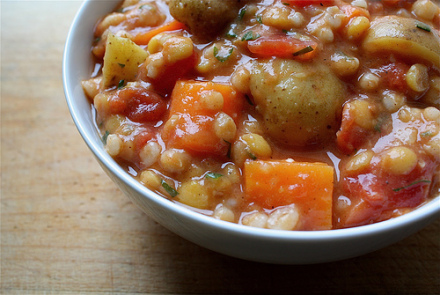Lentil Dal with Tomato & Kale
 Monday, August 9, 2010
Monday, August 9, 2010 Lacinato kale in late June, just before harvesting the first crop and combining ...

... with lentils, tomatoes & spices in this An Honest Kitchen inspired recipe.
Though I'd planned to save this post & recipe until Autumn, these past few days the weather's been cooler and wetter and my mood's been serious and introspective. Neither seems suitable for salads. So the time seems right to share this lovely dal recipe that's warming and comforting as well as simple, tasty and nourishing. Another winner from Kathryn & Lucy.
-------------------------------------------------------------------------------------------------------------------------------------------------------------------------------------------------------------------- Lentil Dal with Tomato & Kale adapted from Lentil Dal with Tomato & Silverbeet in the Autumn 2010 issue of An Honest Kitchen by Kathryn Elliott & Lucinda Dodds. 1 cup (250 mL) split red lentils, washed Some of Kathryn & Lucy's notes with my comments in {parentheses}: Dals get even better after they've been stored in the fridge overnight – the flavours soften and blend. They can also be frozen. {Yes, I enjoyed the dal for lunch the next day & froze a couple of portions for quick meals.) We've chosen to use split red lentils, as they're the quickest cooking. However you could use almost any type of split bean or pea in this recipe. Just be aware it may take longer to cook and need some extra water added during the cooking. {I encourage you try the split red lentils -- they create a lovely colour scheme with the kale & tomatoes.} -------------------------------------------------------------------------------------------------------------------------------------------------------------------------------------------------------------------
--------------------------------------------------------------------------------------------------------------------------------------------------------------------------------------------------------------------
Serves 3 - 4
2 cups (500 mL) water
2 slices fresh ginger
¼ teaspoon (1 mL) turmeric
2 tomatoes, roughly chopped
large bunch of young kale, about 2 cups (500 mL) of harvested leaves without stems, washed and roughly chopped [the original recipe calls for silverbeet]
1 tablespoon (15 mL) canola oil
1 teaspoon (1 mL) mustard seeds
1 bay leaf
1 dried chilli
1 teaspoon (1 mL) ground cumin
1 teaspoon (1 mL) ground coriander
To serve: rice and some natural yoghurt (optional)
Cook the lentils: Put the lentils, ginger and turmeric into a heavy-based saucepan with a lid. Add water. Bring to the boil, turn down to a gentle simmer and place the lid on the pan. Cook for about 15 minutes, stirring occasionally to prevent the lentils from sticking to the bottom of the pan. The lentils should be starting to break down and lose their shape. You may need to add a bit more water, if the dal becomes too thick and gluggy.
Add the vegetables: Add the tomatoes and kale. It will look like way too much greenery at this stage, but don't worry. Give the dal a quick stir and then place the lid back on the pan. Continue cooking gently, for about 10 minutes, until the kale has wilted and softened.
Make the tarka: Heat the oil in a separate small saucepan or frying pan. When hot, but not quite smoking, add the mustard seeds. These should start popping almost immediately. Put in the bay leaf and dried chilli. Cook for a few more seconds, just until these start to brown, and then add the cumin and coriander. Swirl the spices around in the oil for a couple of seconds and then pour the contents of the saucepan into the lentils. The lentils may spit slightly when you do this, so take care. Cover the pan immediately and leave to absorb the flavours for a couple of minutes. Remove the lid, stir and season with salt and pepper.
This makes a mild flavoured dal. If you want more heat, then use a chopped up fresh chilli instead of the dried one. {I like a spicy dal so I'd also add a pinch or two more of the other spices.}
A bowl of dal, with rice and mango chutney is comfort food for me [Lucy] — the silverbeet and tomato make for a wonderful, creamy dish. {Mmmmmm.}
Elaine's nutrition notes:
This tasty combination of three, natural "superfoods" (lentils, tomato, kale) provides a full array of building blocks for good health, particularly protein, fibre, vitamin A, vitamin C, folate, assorted phytonutrients, potassium, calcium and iron. Truly the definition of a nutrient-dense recipe.
Nutrient analysis of Lentil Dal with Tomato & Kale (PDF) - I don't encourage healthy people to "count calories." But some individuals on special diets for health conditions (e.g., kidney disease, iron deficiency anemia, protein-energy malnutrition) may need this information either to make sure they're meeting their needs or not exceeding restrictions.
--------------------------------------------------------------------------------------------------------------------------------------------------------------------------------------------------------------------
--------------------------------------------------------------------------------------------------------------------------------------------------------------------------------------------------------------------
With my second crop of kale ready to harvest and farmers' market tomatoes at their peak, I'll be making this dal again soon.
 5 Comments | |
5 Comments | |  2 References |
2 References |  Permalink | tagged
Permalink | tagged  An Honest Kitchen,
An Honest Kitchen,  dahl,
dahl,  dal,
dal,  harvest,
harvest,  kale,
kale,  lentils,
lentils,  recipes,
recipes,  tomatoes,
tomatoes,  vegan in
vegan in  Recipes
Recipes 



